Electro-thermochemical tank guns. A weapon of the distant future
One of the ways of development tanks is the creation of advanced weapons systems. The possibility of further increasing the caliber and firing characteristics, as well as introducing fundamentally new schemes is being discussed. In recent months, after certain News, there was renewed interest in the so-called. electrothermal or electrothermochemical guns (ETP / ETHP).
Almost a sensation
The newest Russian T-14 tank is equipped with a traditional "powder" cannon 2A82 of 125 mm caliber. For several years, the possibility of improving the combat characteristics of the tank by using the 152-mm 2A83 gun or a similar product has been discussed. At the same time, scientists are already working on the possibility of further strengthening tank guns - through the introduction of fundamentally new technologies.
At the Army 2020 forum in August, the 38th Research and Testing Institute of Armored Vehicles and Armaments presented its views on the tank of the future, which may appear by the middle of the XXI century. and replace the current samples. The presented concept uses the most original solutions, incl. an unusual complex of weapons based on ETHP.
ETCP should use promising propellant charge compositions with electrical impulse ignition. A highly effective charge will allow you to get hypersonic projectile speeds and corresponding combat qualities. The operation of the gun will be provided with an automatic loader. It is expected that a tank with such weapons will have extremely high combat characteristics and surpass the current models. However, the exact parameters of this technique remain unknown. Such a tank of the future and an ETH cannon for it are still only concepts without clear prospects.
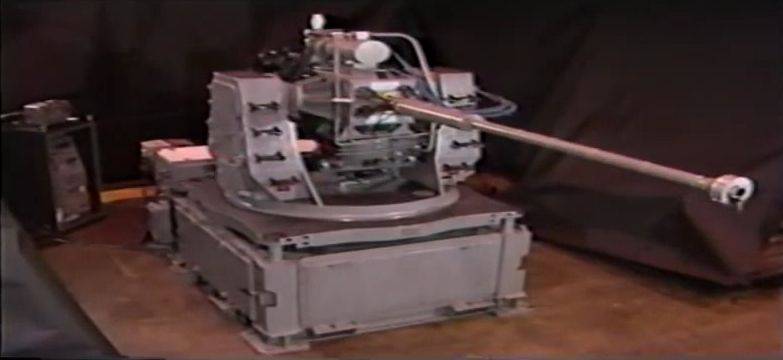
Experimental gun 60 mm Rapid Fire ET Gun of American design. Photo by US Navy
The concept project from the 38th NII BTVT naturally attracted attention, and its discussion continues to this day. For obvious reasons, it is the fundamentally new "main caliber" that has its own advantages and disadvantages arousing the greatest interest in it.
Principles and Benefits
The well-known ETHP projects are generally similar and provide for general operating principles. Such a gun must have a rifled or smooth barrel, as well as a breech of a special design, which ensures the implementation of all processes. It is possible to use unitary, separate-sleeve or modular propelling charges on a solid or, in theory, a liquid substance.
Some variants of the ETHP concept suggest heating the propellant before it is fed into the chamber; the feed itself can be carried out under pressure. Then, with the help of an electrical control system, the plasma source is ignited, which ignites the propellant charge. Energy from electrical ignition is added to the energy of the charge and increases the overall performance of the weapon. In theory, such a gun can control the rate of combustion of the main charge in order to optimize performance.
Thus, the combination of a traditional chemical propellant charge and new electrical means can give a significant increase in performance. For example, a tank with ETHP will be able to shoot further and / or hit targets with more powerful protection. There are also projects like weapons for ships and other platforms.
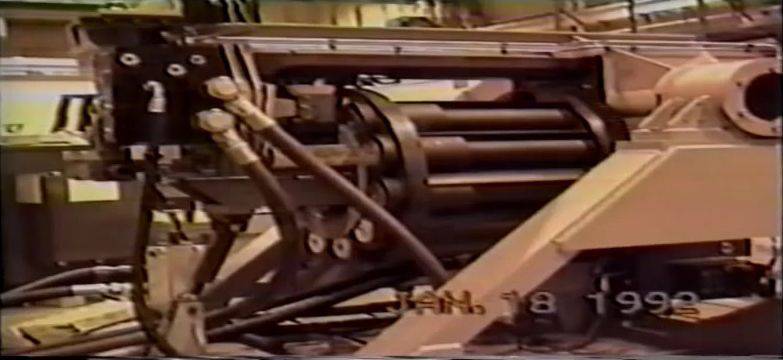
Drum of the American cannon. Photo by US Navy
From theory to practice
The concept of an electrothermochemical gun appeared quite a long time ago, and by now several experimental projects of this kind have been created. However, the number of such projects is small, and their results were much more modest than expected. As a result, not a single ETKhP has gone beyond the experimental ranges.
At the turn of the eighties and nineties, a rapid-firing 60 mm ETHP was developed in the United States. The experimental gun 60 mm Rapid Fire ET Gun received an automatic system based on a drum with 10 chambers for unitary shots, as well as special fire controls. The gun was tested in 1991-93. and showed the fundamental possibility of creating a workable system of a new class. However, the project was not developed due to technical difficulties, high cost and lack of significant advantages over "chemical" artillery.
During the same period, a similar system was being developed by British specialists from Royal Ordnance. The ROSETTE project (Royal Ordnance System for Electrothermal Enhancements) envisaged the creation of several experimental ETC with a sequential improvement in characteristics. In 1993, he managed to create and test a cannon capable of accelerating a kilogram projectile to a speed of 2 km / s. The work continued, incl. with the involvement of foreign organizations, but the real result has not yet been obtained. British and foreign armored vehicles, ships, etc. continue to use traditional artillery.
In the early nineties, the development of ETHP was undertaken by the Israeli scientific center "Sorek" in cooperation with several US organizations. The SPETC (Solid Propellant Electro-Thermal Chemical) project proposed the use of a gun based on available components with an existing propellant charge, which had to be supplemented with new electrical components. It was found that plasma electric ignition can increase the energy of the projectile by 8-9 percent. In particular, this would make it possible to disperse sub-caliber projectiles of 105-mm cannons to 2 km / s and more. However, the SPETC project also did not leave the testing stage.
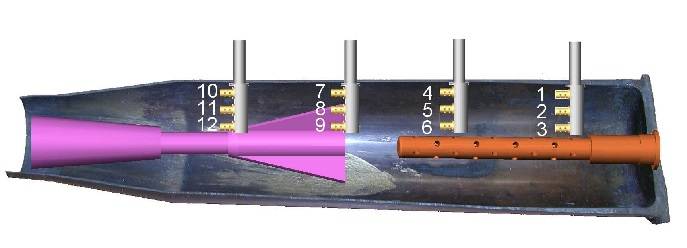
SPETC projectile design. Graphics Center "Sorek"
In our country, the topic of ETHP got interested quite late. According to known data, real research in this direction began only in the tenths. The topic of ETH guns was studied along with other methods of increasing the combat characteristics of tanks. Nothing is known about the production of prototypes. So far, we are talking only about theory and concept projects that demonstrate theoretical capabilities.
Technical challenges
Well-known ETHP projects show how difficult it is to implement the original concept. Several different engineering problems need to be solved, some of which require completely new and unusual solutions. In fact, the ETHP project can be divided into several areas: an artillery unit, ammunition, means of ignition and fire control.
The barrel and breech system will have to be redesigned. The use of ready-made components, as the SPETC project shows, does not allow obtaining a significant increase in characteristics. In addition, the savings in components are minimal. When creating a system with a large increase in characteristics, it will be necessary to develop a reinforced barrel that can withstand increased loads, a breech of a special design for feeding shot components, as well as means for storing and supplying ammunition.
To obtain maximum characteristics, a shot for ETHP needs new solutions in the field of projectile materials. New propellants or alternative formulations are needed, as well as a means of generating plasma. Certain results have been obtained in both areas, but the revolution in artillery is still far from it.
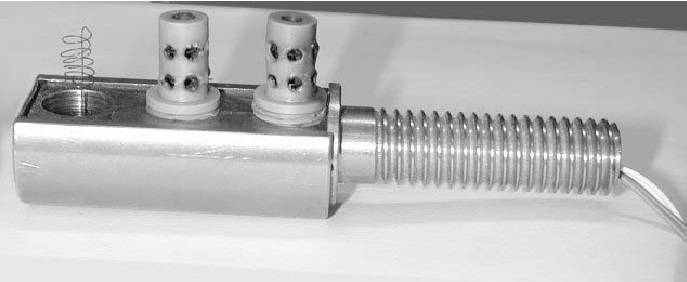
Plasma projectile igniter SPETC. In the picture above, such devices are marked with numbers. Photo Center "Sorek"
The formation of plasma during firing is carried out using a high-power electrical impulse, which is why the ETHP needs an appropriate source of energy. Systems with the required characteristics so far can be used only on large ships or as part of containerized complexes. Compact platforms such as a tank or an ACS cannot yet count on a high-power source of energy.
Already in the early nineties, the level of technology made it possible to create an experimental electrothermochemical gun, albeit with limited characteristics. Further development of technologies allows counting on the growth of parameters and capabilities, but so far the concept of ETHP is not ready for the development of practically applicable systems and for their implementation in the troops.
Weapons of the future
The ETHP concept has been known for a long time and was even implemented in practice in the form of early prototypes. However, further work did not progress, and priority was given to other options for "alternative" artillery. The current level of technology does not yet allow creating the desired ETH cannon, and the military of the leading countries, apparently, do not yet see the point in it.
However, science and technology do not stand still. In the coming decades, we can expect the emergence of new technologies capable of providing a breakthrough in all promising areas. It should be remembered here that the concept of a tank from the 38th NII BTVT belongs precisely to the distant future. And by the beginning of its development, the necessary solutions and components may appear at the disposal of tank builders.
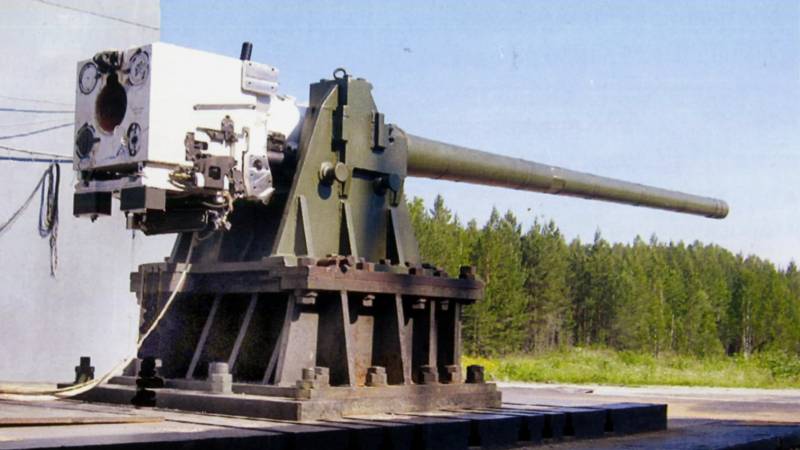
Information